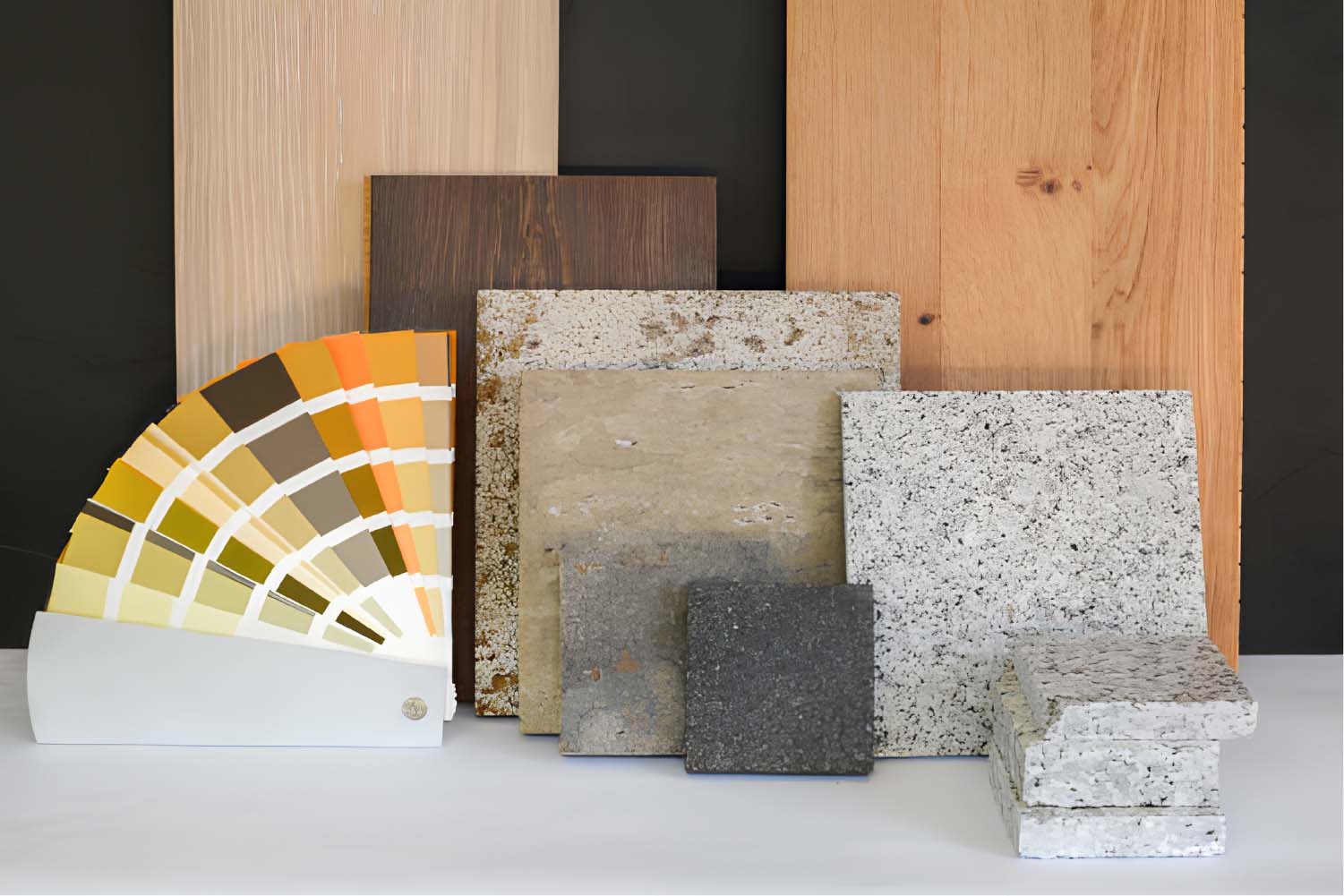Is it really possible to get beautiful, durable flooring without breaking the bank? In 2025, it is.
Flooring is one of the biggest investments in any renovation or new build, but that doesn’t mean it has to be the most expensive. The real challenge for many homeowners and property managers is keeping the right balance between affordability, appearance, longevity, and performance.
When it comes to flooring, “affordable” doesn’t mean “cheap”—and it certainly doesn’t mean you’re limited to outdated designs or flimsy materials. The advanced manufacturing and material science is helping in making budget-friendly flooring options that can realistically mimic hardwood, stone, or ceramic—at a fraction of the cost.
In this guide, we’ll break down the most inexpensive flooring options available today and how they hold up over time in real-world conditions.
1. Vinyl Flooring (Sheet, Plank, and Tile)
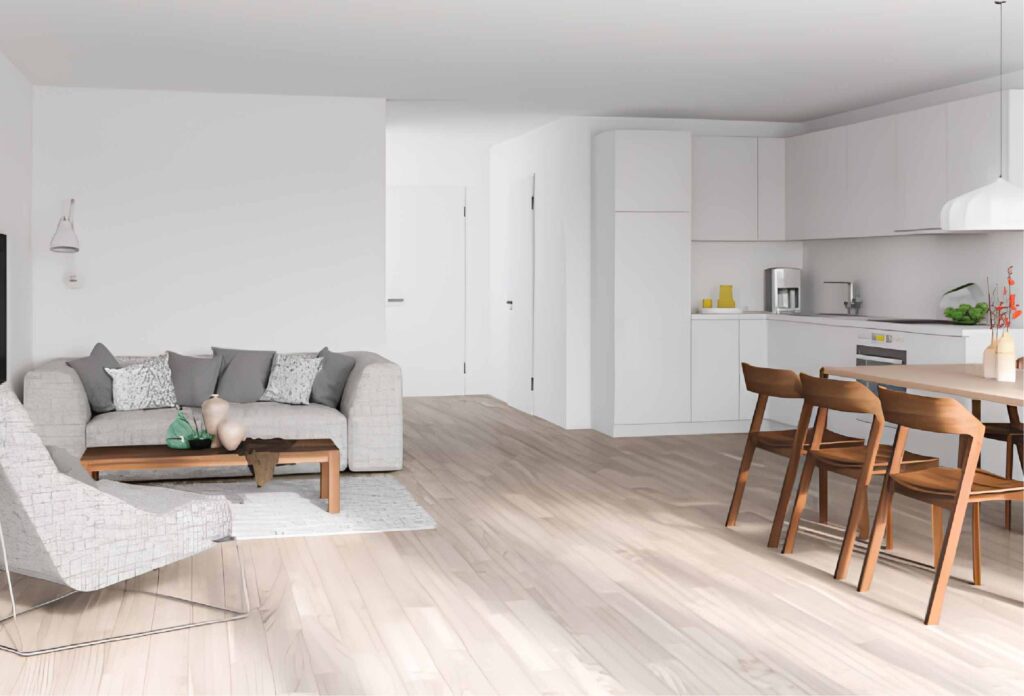
- Cost Range: $2 – $10 per sq. ft
- A Great Fit For: Kitchens, bathrooms, basements, and high-moisture areas
Vinyl flooring contains PVC combined with other agents to make the flooring durable and waterproof. Plain tiles with sticky backs or luxurious planks that mimic the appearance of wood, stone, or tile. It has a realistic texture and is affordable to many who desire stylish flooring and are not willing to spend much money.
Some newer versions, especially those with stone plastic composite (SPC) or rigid cores, provide more strength against dents and help keep the planks stable over time. For those who like to handle their own home projects, vinyl is simple to put in without much help.

| PROS | CONS |
| Water-resistant and stain-resistant | Off-gassing risk |
| Available in many patterns and colors | Lower-quality vinyl may fade over time |
| DIY-friendly and low-maintenance | |
| Softer and warmer underfoot |
2. Laminate Flooring
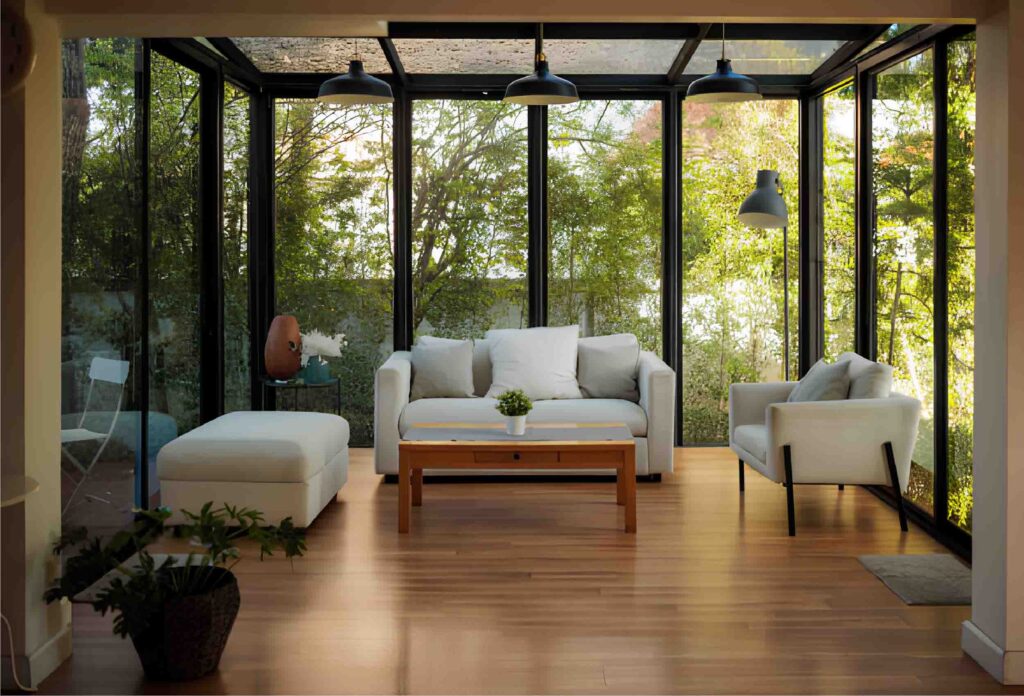
- Cost Range: $3– $15 per sq. ft
- A Great Fit For: Living rooms, bedrooms, home offices
Laminate flooring is made of a dense fiberboard material (usually high-density fiberboard, or HDF), and laminated on top of the dense board by a high-resolution photographic film to resemble a wood or tile appearance, and sealed with a clear protective wear layer. It has an aluminum oxide wear layer and thus, it is thus very scratch-resistant and thus, is suitable for high-traffic areas.
Many modern laminates also offer water-resistant options through waxed edges and sealed joints. The floating installation via click-lock systems allows for a glue-less, nail-free process, which is ideal for DIY projects. Affordable laminate flooring balances luxury aesthetics with functional durability.

| PROS | CONS |
| Scratch- and fade-resistant topcoat holds up well under daily wear | Not completely waterproof unless specified |
| Click-lock floating systems simplify DIY projects | Can sound hollow underfoot |
| Endless wood species, colors, and textures | Non-refinishable |
| Wood-look finish at a fraction of the cost |
3. Engineered Wood (Low-Cost Options)
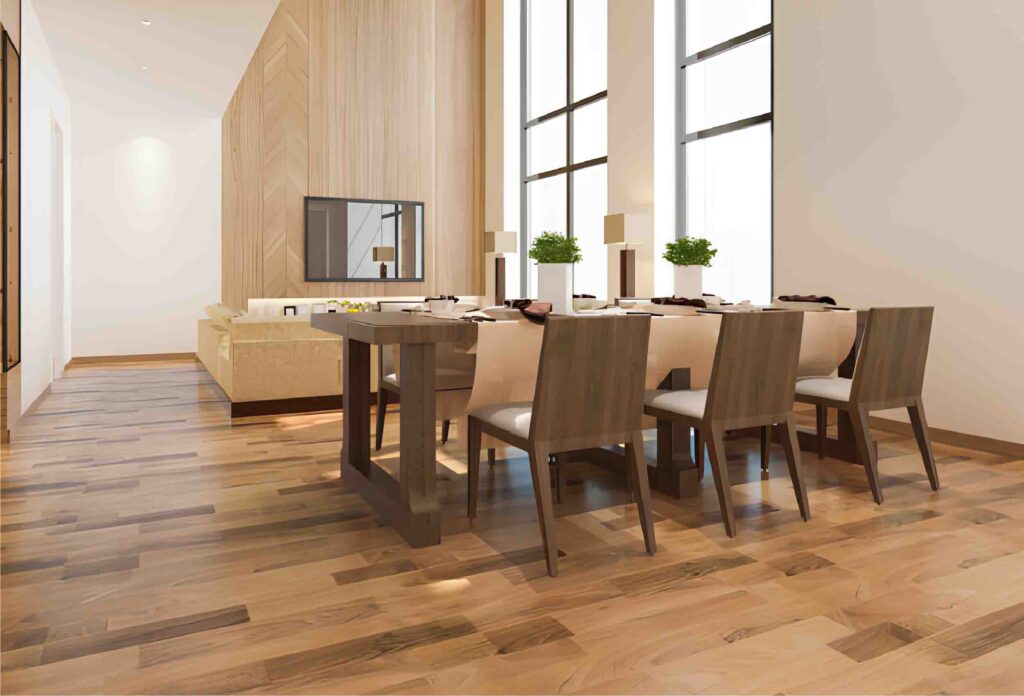
- Cost Range: $3 – $16 per sq. ft
- A Great Fit For: Dining rooms, bedrooms, upscale rental units
A surface of true hardwood, like maple or oak, is bonded to a core made from plywood or fiberboard in engineered wood floors. This structure gives them greater resistance to expansion and contraction, unlike solid hardwood boards.
Some types come in thinner cuts, which might not allow refinishing more than once, or not at all. Still, they give the same warm wood appearance for much less money. Radiant heating systems usually work well with this type of floor.
It could be installed by nailing, gluing, or floating, depending on the space and subfloor. The engineered hardwood in various colors is appropriate for a house that requires a fancy wood floor without overspending.

| PROS | CONS |
| Real wood surface, natural grain, knots, and texture | Limited refinishing potential |
| Resists cupping and shrinking in humid climates | Prone to dents if not handled well |
| Enhances property value compared to laminate | |
| Flexible installation(some are click-lock) |
Get clear on the debate: engineered hardwood vs. solid wood, and know what suits your home best.
4. Stained Concrete
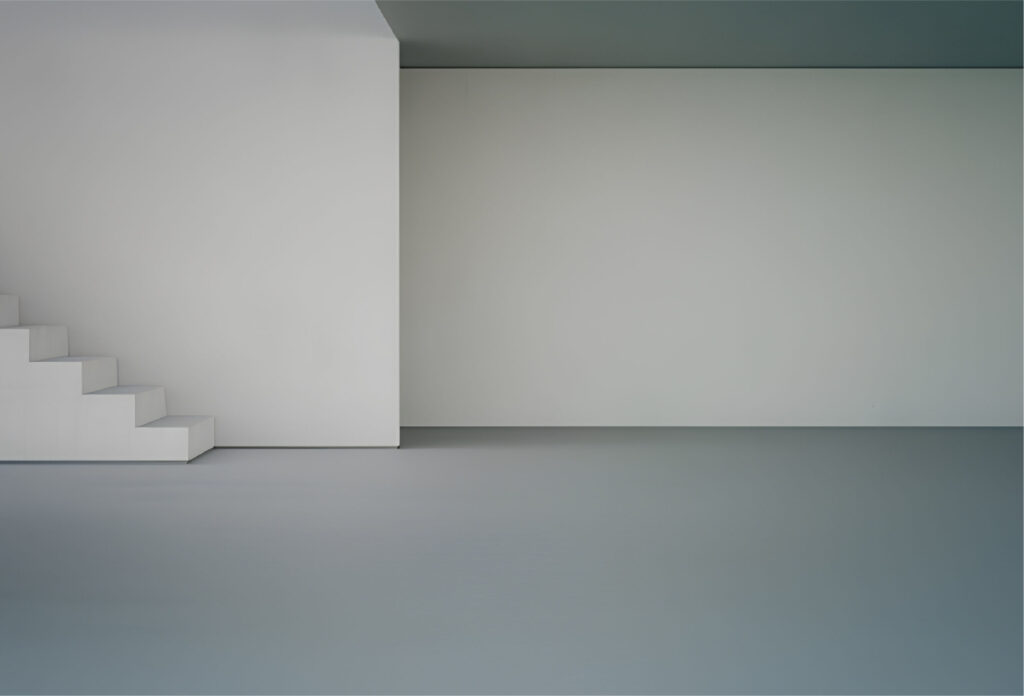
- Cost Range: $2 – $24 per sq. ft
- A Great Fit For: Basements, modern lofts, minimalist spaces
Different concrete floors are stained with acid-based or water-based stains. These stains are absorbed into the cleaned material, and they mix with the minerals contained in the slab. The result of this chemical reaction is the appearance of natural-type patterns, the meaning of which is the existing earthy browns, smoky grays, or even deep blues.
A sealing layer added at the end boosts the floor’s defense against water damage and daily wear. It also gives the surface a clean, finished look. People often go for it because it doesn’t trap dust and stays clean longer. Mold and mildew don’t stand a chance either. It keeps floors looking new without too much effort.
Radiant heat systems pair well with this style of flooring. In homes aiming for efficiency and reduced upkeep, stained concrete delivers a streamlined and modern look without driving up the cost.
| PROS | CONS |
| Resists scratches, moisture, and wear | Feels hard and cold underfoot |
| Custom looks with stains, dyes, and scoring create unique designs | Can crack if not installed correctly |
| Eco-friendly, uses existing slab, reducing waste | |
| Allergen-free |
5. Peel-and-Stick Tiles
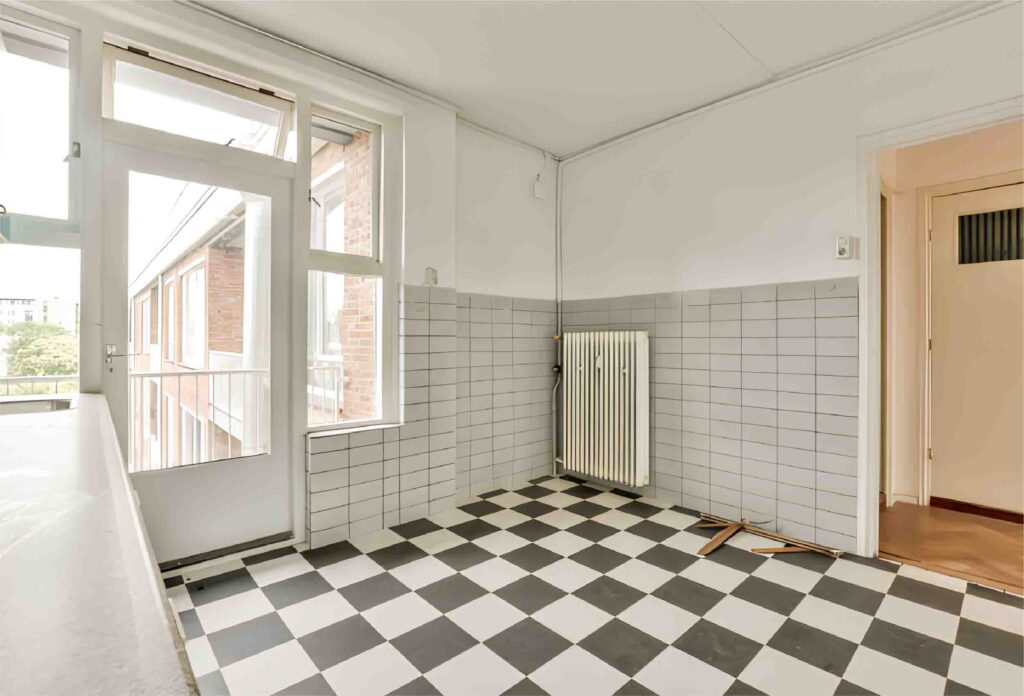
- Cost Range: $0.50 – $8 per sq. ft
- A Great Fit For: Rental homes, bathrooms, small DIY projects
Peel-and-stick tiles are vinyl-backed squares with pre-applied adhesive. They come in endless patterns, including wood-look, marble-look, or mosaic styles. Simply peel off the backing and press into place.
Renters like these tiles because they come up with low maintenance. They’re a good option when you just want to give your kitchen or bathroom a fresh, new look without spending too much time or effort.
While peel-and-stick floor tiles are cheap and easy to install, their longevity depends on surface prep and humidity control.
| PROS | CONS |
| Super easy to install | May not last as long as traditional tiles |
| Easy to replace or remove | Weak adhesive in humidity |
| DIY dream, no tools or adhesives needed |
6. Painted Plywood
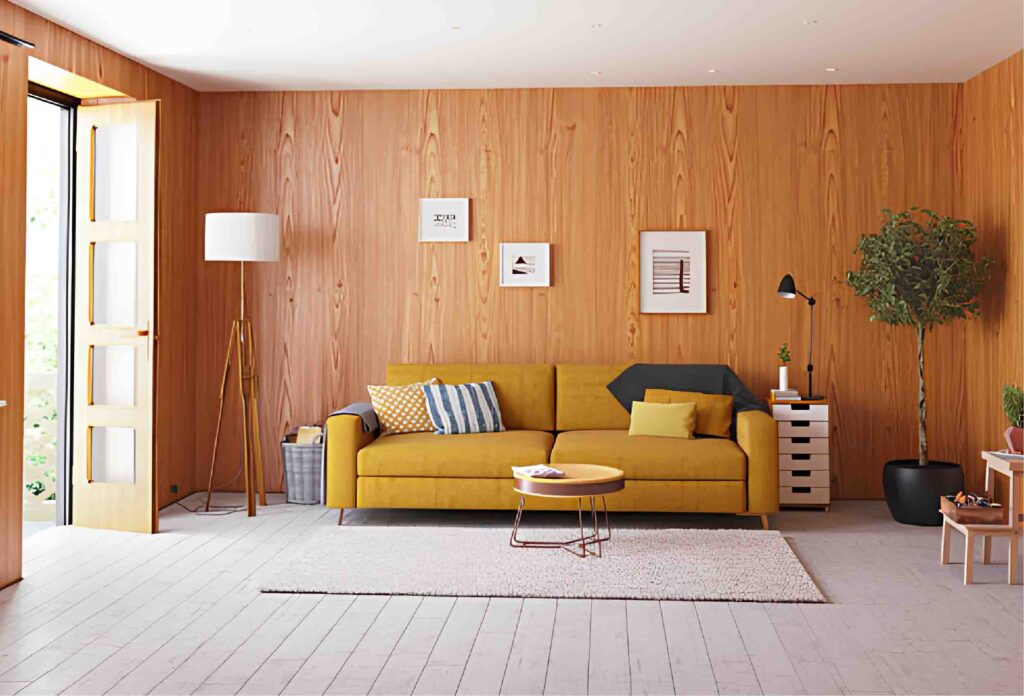
- Cost Range: $0.50 – $9 per sq. ft
- A Great Fit For: Rustic homes, cottages, attics, or low-traffic areas
Painted plywood flooring involves sanding down sheets of construction-grade plywood, applying primer, and painting with durable floor or porch paint. Patterns like checkerboards or faux planks can be stenciled on, then sealed with polyurethane for protection.
You won’t find many DIY flooring ideas as affordable and flexible as this. Painted plywood uses the subfloor you already have, so there’s little to no waste involved. It won’t hold up well to moisture, though, so it’s better for dry indoor spaces. Still, for anyone working with a tight budget and wanting a cozy, rustic look, it works like a charm.
| PROS | CONS |
| Fully customizable designs | Not suitable for moisture-prone areas |
| Sustainability reuses materials instead of replacing them | Requires sealing and upkeep |
| DIY-friendly, requires basic tools and paint supplies | |
| Highly customizable |
7. Carpet Tiles
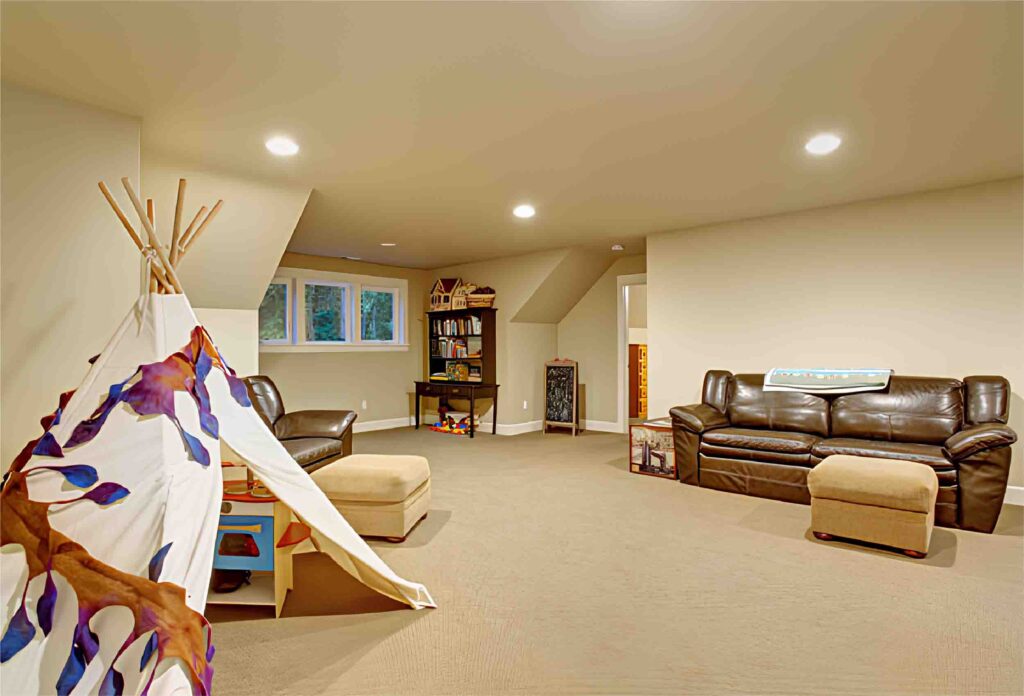
- Cost Range: $1 – $5 per sq. ft
- A Great Fit For: Bedrooms, Playrooms, Basements
Square carpet tiles stick directly to the floor using glue or built-in adhesive layers. Because of their modular shape, they’re easy to handle. When one gets dirty or worn, swap it without touching the rest.
Many textures and colors are available. These tiles help quiet the room and make walking more pleasant. They work well in high-use areas like family rooms and home offices. Some tiles use recycled materials, and a lot are built to resist stains and spills.
If you need soft floors that won’t break your budget, carpet tiles can be a smart, flexible option to consider.
| PROS | CONS |
| Reduces noise in multi-floor homes or offices | May show seams |
| Mix and match colors or patterns | Susceptible to stains |
| Replace only damaged tiles instead of the whole floor | Not water-resistant |
| Provides cushioned comfort, especially for children |
Budget-Friendly Flooring Quick Comparison Table
Here is a comprehensive comparison to assist you in making an informed decision about your affordable flooring.
| Flooring Type | Installation Ease🛠️ | Durability 🧱 | Suitable Spaces🏡 |
| Vinyl Flooring | Easy (DIY or Pro) | High (Waterproof & stain-resistant) | Kitchens, Bathrooms, Basements, Laundry Rooms |
| Laminate Flooring | Easy (Click-lock DIY) | Moderate to High (Scratch-resistant, less water-resistant) | Living Rooms, Bedrooms, Offices |
| Engineered Wood | Moderate (Glue/Nail/Click) | High (Stable, limited refinishing) | Dining Rooms, Bedrooms, High-end Rental Units |
| Stained Concrete | Professional preferred | Very High (Permanent, low maintenance) | Basements, Modern Lofts, Minimalist Spaces |
| Peel-and-Stick Tiles | Very Easy (Peel & stick) | Low to Moderate (Adhesive may fail in moisture) | Bathrooms, Rental Homes, Temporary Spaces |
| Painted Plywood | Moderate (DIY paint/seal) | Low to Moderate (Needs sealing) | Cottages, Rustic Spaces, Low-traffic Rooms |
| Carpet Tiles | Easy (Peel & stick or glue) | Moderate (Stain-prone, modular replacement) | Bedrooms, Playrooms, Basements |
Tips to Save More on Flooring
Lowest-cost material is not the budgeting for a flooring project; it’s about making smart decisions throughout the selection, purchase, and installation process.
1. Buy in Bulk or Closeout Batches
Manufacturers often liquidate discontinued lines at 30–70% off retail prices:
- Use matching SKU codes to avoid color/shade variation between boxes
- Always purchase from the same lot/batch to ensure uniform finish and fit
- Ask for full pallets to negotiate wholesale pricing directly with suppliers
2. Calculate Exact Square Footage with Waste Factor
Before purchasing, accurately measure the area and add a waste allowance:
Standard waste factor
- 5–10% for square rooms
- 10–15% for irregular rooms or patterns (like diagonal tile or herringbone)
Overestimating waste leads to unnecessary material costs; underestimating may force you to buy from a different batch, risking color or texture mismatch.
3. Compare Wear Layer Thickness & AC Ratings
For laminate and vinyl, durability is determined by technical specifications, not price alone:
Laminate AC Rating (Abrasion Class):
- AC3: Moderate residential use
- AC4: Heavy residential/light commercial use bvvvvv
Vinyl Wear Layer Thickness:
- 6–12 mil: Budget/residential
- 20+ mil: High-traffic or commercial
Choose based on your space, not marketing. This way you’ll avoid overpaying for features you don’t need.
Find the Most Affordable Flooring for Your Home
A stylish home doesn’t have to cost a fortune. DamosaFloors brings you flooring that fits both your needs and your wallet. We offer a large collection of long-lasting materials like carpet tiles, vinyl planks, or durable laminate for your kitchen, bathroom, and living room.
Need help in choosing the right flooring? Call now (+1) 480-487-4649, our experienced team guides you through smart options, whether you’re working on a small update or planning a full remodel. No stress. No inflated prices. Just practical flooring that looks great and holds up over time.

